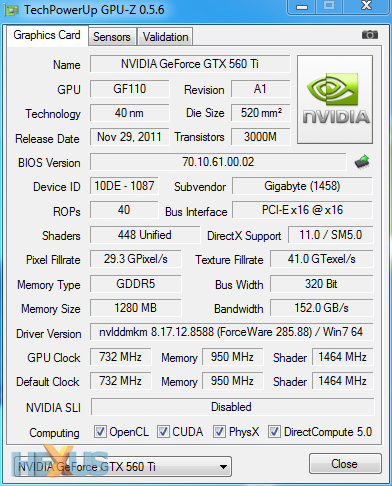Test methodology
Gigabyte GV-N560448-13I specification |
|---|
 |
GPU comparisons |
||||||||
|---|---|---|---|---|---|---|---|---|
| Graphics card | Approx. pricing |
GPU clock (MHz) |
Stream processors |
Shader clock (MHz) |
Memory clock (MHz) |
Memory bus (bits) |
Graphics driver | |
| NVIDIA GeForce GTX 570 (1,280MB) | £240 | 732 | 480 | 1,464 | 3,800 | 320 | ForceWare 285.88 | |
| Gigabyte GeForce GTX 560 Ti 448 (1,280MB) | £220 | 732 | 448 | 1,464 | 3,800 | 320 | ForceWare 285.88 | |
| NVIDIA GeForce GTX 560 Ti (1,024MB) | £170 | 822 | 384 | 1,645 | 4,008 | 256 | ForceWare 285.88 | |
| AMD Radeon HD 6970 (2,048MB) | £255 | 880 | 1,536 | 880 | 5,500 | 256 | Catalyst 11.11a | |
| AMD Radeon HD 6950 (2,048MB) | £185 | 800 | 1,408 | 800 | 5,000 | 256 | Catalyst 11.11a | |
| AMD Radeon HD 6870 (1,024MB) | £140 | 900 | 1,120 | 900 | 4,200 | 256 | Catalyst 11.11a | |
High-end test bench |
||||||||||||
|---|---|---|---|---|---|---|---|---|---|---|---|---|
| Processor | Intel Core i5-2500K (3.33GHz, 6MB smart cache, quad-core, LGA1155) | |||||||||||
| Motherboard | Intel Desktop Board DP67BG | |||||||||||
| Memory | 8GB Corsair Vengeance (9-9-9-24 @ 1,600MHz) | |||||||||||
| Power Supply | Corsair AX750W | |||||||||||
| Monitor | Dell 30in 3007WFP | |||||||||||
| Disk drive(s) | Crucial RealSSD C300 (256GB) | |||||||||||
| Chassis | Corsair Graphite Series 600T | |||||||||||
| Operating system | Windows 7 Ultimate (64-bit, SP1) | |||||||||||
High-end benchmark suite |
||||||||||||
|---|---|---|---|---|---|---|---|---|---|---|---|---|
| 3DMark 11 | Performance and Extreme presets | |||||||||||
| Aliens vs. Predator | DX11, 1,920x1,080 and 2,560x1,600 resolutions, 4xAA, 16xAF, very high quality | |||||||||||
| Battlefield 3 | DX11, 1,920x1,080 and 2,560x1,600 resolutions, 4xMSAA, 16xAF, ultra quality | |||||||||||
| Crysis 2 | DX11, 1,920x1,080 and 2,560x1,600 resolutions, 4xAA, ultra quality | |||||||||||
| Just Cause 2 | DX10, 1,920x1,080 and 2,560x1,600 resolutions, 4xAA, 16xAF, very high quality | |||||||||||
| Total War: Shogun 2 | DX11, 1,920x1,080 and 2,560x1,600 resolutions, 4xMSAA, 16xAF, high quality | |||||||||||
| Folding@home | Using the GPU2 and GPU3 clients, we calculate the the points per day (PPD) performance of each graphics card | |||||||||||
| Power consumption | To emulate real-world usage scenarios, we record mains power draw both when idle and whilst playing Crysis 2 | |||||||||||
| Temperature | To emulate real-world usage scenarios, we record GPU core temperature both when idle and whilst playing Crysis 2 | |||||||||||
| Noise | A PCE-318 meter is used to record noise levels when idle and whilst playing Crysis 2 | |||||||||||
| Overclocking | Pushing the graphics card as far as it will go, we increase speeds and re-run the Aliens vs. Predator benchmark | |||||||||||
| HEXUS bang4buck | A custom metric used to evaluate comparative performance with price factored in | |||||||||||
Notes
In preparation of a slew of new GPUs in 2012, we're using this opportunity to introduce a refreshed test machine. Our old X58 platform has been put to rest, and a new Intel P67 system has been put in place with a Core i5-2500K processor, 8GB of memory and solid-state storage.
Coinciding with the new high-end platform, we are also refreshing our benchmark suite with a few high-profile additions - including Battlefield 3, Crysis 2 and Total War: Shogun 2. Once the DX11 issues are ironed out, Batman: Arkham City will complete the line up.
And, by popular demand, we are also taking a look at the Folding@home performance of various GPUs. To get our new platform and benchmarks up and running, we've tested six high-end graphics cards from the ground up; three from NVIDIA, three from AMD.









